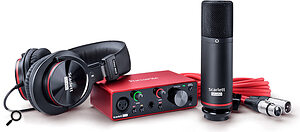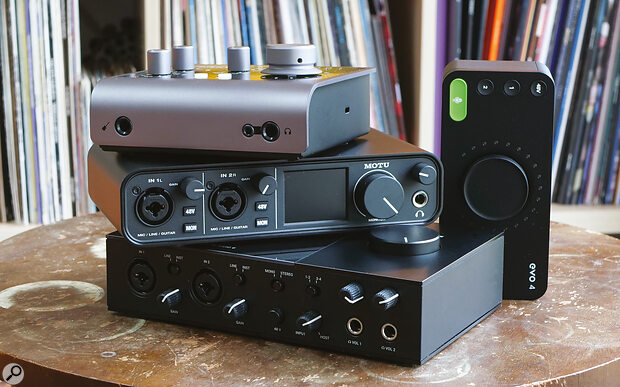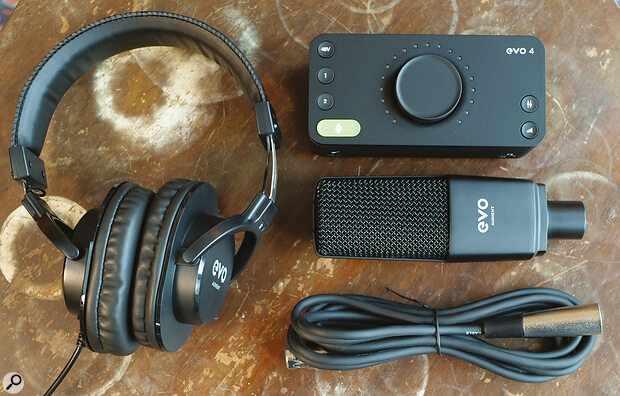There’s an overwhelming number of low-cost audio interfaces out there, so how do you choose the right one for you?
Nothing improves the quality of your computer‑based music‑making experience more than an audio interface. It provides the hardware connections for recording the outside world, and the hands‑on knobs and buttons for controlling your levels. It bridges the gap between musician and recording medium, enables all of your music software to work correctly and makes the whole experience feel like a studio rather than a computer game.
The number of possible options and the range of features can be quite baffling, but working out what you want to achieve can help narrow the field. This is especially important when you’re on a budget, and every feature has to have genuine value.
What’s The Budget?
That’s always a good question to kick off with, and for this article my assumption is that we’re talking entry‑level, simplicity and not wanting to spend more than the cost of a decent plug‑in. Flexibility can also be useful, because audio interfaces don’t tend to be purchased in isolation. Other things such as microphones, headphones and cables will start stretching your available cash. I’d recommend earmarking around £100$150 for a half‑decent entry‑level audio interface, though this is being continually challenged by companies pitching into that beginner’s market with cheaper and simpler audio interfaces. Most recently, the M‑Audio M‑Track Solo and Duo interfaces manage to tick the ‘half‑decent’ box at under £50$50. Familiar brand names such as PreSonus, Native Instruments, Focusrite, Behringer, Mackie and Steinberg all have sub‑£100$150 interfaces that would do the job nicely depending on what that job is.
 M‑Audio’s sub‑£50/$50 M‑Track Solo might offer everything you need to start recording.There does come a point where that cheapness is reflected in the build quality, sound quality and functionality. For Windows users, in particular, the interface must come with properly designed ASIO drivers that provide a low‑latency connection between interface and recording software. Any interface that depends upon native Windows audio drivers or requires the third‑party ASIO4ALL driver will be disappointing in terms of latency when recording and the responsiveness of virtual instruments. Except for the M‑Audio boxes, I’ve found that ASIO drivers tend to be offered with interfaces closer to the £100$150 mark. With Mac OS and iOS you are reliant on Core Audio and Class Compliance, so these issues are of no concern.
M‑Audio’s sub‑£50/$50 M‑Track Solo might offer everything you need to start recording.There does come a point where that cheapness is reflected in the build quality, sound quality and functionality. For Windows users, in particular, the interface must come with properly designed ASIO drivers that provide a low‑latency connection between interface and recording software. Any interface that depends upon native Windows audio drivers or requires the third‑party ASIO4ALL driver will be disappointing in terms of latency when recording and the responsiveness of virtual instruments. Except for the M‑Audio boxes, I’ve found that ASIO drivers tend to be offered with interfaces closer to the £100$150 mark. With Mac OS and iOS you are reliant on Core Audio and Class Compliance, so these issues are of no concern.
So, in terms of budget, I will be talking about interfaces in a range of around £50‑£150$50‑$200 just to give us some leeway. All of these will be USB interfaces: the words ‘budget’ and ‘Thunderbolt’ rarely occur together in the same sentence! Many have USB‑C sockets, but all will work with both Type‑C and Type‑A ports on your computer.
You can absolutely produce music on a computer with an audio interface that costs less than a couple of piano lessons.
Audio Connections
The next question you should ask yourself is: what am I hoping to record? Then if you pull back slightly, you can turn the question into the more specific ‘What do I want to plug into this box?’ Is it just you, your voice, or you and guitar? Do you have other instruments, synthesizers or friends that make noise that you want to record?
Your bog‑standard audio interface is going to give you two inputs. The simplest ones give you one microphone input and one guitar input, but you’ll generally get two combi XLR inputs which can be either for microphones or line‑level sources. You then use a knob to set the level. If you are using a capacitor microphone, you need to make sure the interface has a +48V phantom power switch for at least one microphone input. Instruments with pickups, such as electric guitars, need to ‘see’ a higher input impedance, and you’ll often find a separate input or a switch to make an input more accommodating to these sources. So, if recording guitar directly into your computer is something you want to do, make sure the interface has this facility.
 Focusrite Scarlett Solo interface with Studio bundle.
Focusrite Scarlett Solo interface with Studio bundle.
If it’s just you and guitar, there are several good ‘Solo’ interfaces. The NI Komplete Audio 1, PreSonus AudioBox iOne, Steinberg UR‑12, Mackie Onyx Artist, Focusrite Scarlett Solo and the M‑Audio M‑Track Solo are great examples at well under £100$150.
Is two inputs going to be enough for you? You may have a hardware synthesizer or piano to plug in, and while you can always swap out cables when multitracking, it might be more convenient to have your synth or a mixer plugged more permanently into additional inputs. Audio interfaces can offer multiple inputs, but unfortunately that sort of thinking will immediately bust your budget. For four inputs you’ll be looking to spend nearer £200$300. Good examples are the MOTU M4, Native Instruments Komplete Audio 6, Focusrite Scarlett 4i4 and Audient EVO 8.
On the output side, a simple stereo output and a headphone socket are probably all we can hope for and really, for entry level, that’s all you need. If you’re working with a friend then you will find dual headphone sockets on some interfaces, but as with increasing the number of inputs, you’re heading over £200$300 again with interfaces such as the Focusrite Scarlett 8i6, Steinberg UR44C, SSL 2+ and M‑Audio AIR 192 14.
MIDI
A built‑in MIDI interface may not be high on your list of priorities. Most MIDI gear has its own USB ports, and so MIDI sockets on audio interfaces tend to be useful only with older hardware synthesizers and keyboards. At this level, few audio interfaces include MIDI ports. Notable exceptions include the Steinberg UR22 MkII and PreSonus AudioBox iTwo, but both are over the £100$150 mark.
Hardware Controls
There seem to be two styles of layout for small audio interfaces. The more common is the 1U‑high, half‑rack unit that tries to look like a piece of professional audio equipment. The more recent trend is for manufacturers to realise that no beginner cares about rack units, and instead slap the controls on the top, making it more desktop‑friendly. I prefer desktop interfaces; a big knob on the top makes it very easy to control volume.
Do consider the smallness of the front panel and the accessibility of the gain knobs for the microphone inputs and the controls for output level. They can be very annoying if you are holding a guitar and trying to adjust levels.
Rigidity
Depending on your recording environment’s calmness, the ability of an interface to survive being dropped off the kitchen table or trodden on is another factor. While brilliantly priced, for example, the M‑Audio M‑Track Solo and Duo interfaces are made of plastic and are so light that they struggle to stay upright with cables plugged in. Just because something is made of plastic doesn’t mean it will fall apart, but if you are looking for a bit of ruggedness, you’ll need to look higher up the budget scale for metal casings. Interfaces from Steinberg, PreSonus, Focusrite and MOTU would fit the bill here.
Sound Quality
 SSL 2+ audio interface.Spending time thinking about sound quality is the sort of thing people with more money have the luxury of doing. Manufacturers put an enormous amount of effort into squeezing great preamps into little boxes at a reasonable cost. Whether it’s M‑Audio and their ‘Crystal’ preamps, PreSonus’s Class‑A preamps or the JFET input on the Audient EVO 4, they all offer decent sound quality even at this level. The published specs are always impressive, with manufacturers trying to outdo each other in offering high dynamic ranges and low noise floors. In practice you will struggle to tell them apart, especially on the output side.
SSL 2+ audio interface.Spending time thinking about sound quality is the sort of thing people with more money have the luxury of doing. Manufacturers put an enormous amount of effort into squeezing great preamps into little boxes at a reasonable cost. Whether it’s M‑Audio and their ‘Crystal’ preamps, PreSonus’s Class‑A preamps or the JFET input on the Audient EVO 4, they all offer decent sound quality even at this level. The published specs are always impressive, with manufacturers trying to outdo each other in offering high dynamic ranges and low noise floors. In practice you will struggle to tell them apart, especially on the output side.
However, one area where differences can be noticeable is in the amount of gain available on the mic preamps. For recording spoken word and other quiet sources, you’ll need plenty of clean gain, as found, for example, on the SSL 2 and 2+. The flip side of this is that you usually get less headroom for very loud sources such as drums and guitar amps.
Sample rate and bit depth are also worth considering. While the value of high sample rates is debatable, you certainly want to be able to record at 24‑bit.
Low‑latency Monitoring
Most interfaces offer low‑latency monitoring features that allow you to hear input sources directly at the output. These aren’t a substitute for good ASIO or Core Audio drivers, but they can be very useful. Some interfaces in this price bracket, like the MOTU M2 and SSL 2, implement this using a physical control. Others, like the Audient EVO 4, have a built‑in digital mixer that is controlled from software. The software‑controlled approach is generally more versatile and flexible, but it’s also more complex and means you have to tab between your recording software and the interface control panel to get things set up.
Software
 The value of bundled software like Steinberg’s Cubasis is not to be discounted.All affordable interfaces come with a bundle of software to get you recording. The assumption is that you don’t have any music software, and that this is your first time making music on a computer. If that’s true for you, then this is a really useful tradition. Most commonly, Ableton Live Lite seems to be given away free with everything. But you’ll also find Avid’s Pro Tools Free with M‑Audio interfaces, Cubasis or Cubase AI with Steinberg and the Artist version of Studio One with PreSonus boxes.
The value of bundled software like Steinberg’s Cubasis is not to be discounted.All affordable interfaces come with a bundle of software to get you recording. The assumption is that you don’t have any music software, and that this is your first time making music on a computer. If that’s true for you, then this is a really useful tradition. Most commonly, Ableton Live Lite seems to be given away free with everything. But you’ll also find Avid’s Pro Tools Free with M‑Audio interfaces, Cubasis or Cubase AI with Steinberg and the Artist version of Studio One with PreSonus boxes.
Some interfaces also sweeten the deal with additional effect plug‑ins or VST instruments. Focusrite have their own range of plug‑ins included, M‑Audio benefit from association with AIR Instruments and you’ll find all sorts of things given away in a bundle. It’s worth checking out what software is on offer with your shortlisted interfaces.
Special Features
There may be an extra feature that particularly appeals to your needs. One recent development is the ‘Loopback’ facility which allows the output of one piece of software to reappear as an input for recording in another piece of software. This is useful for podcasting or live‑streaming, for example, where you can send the output of your DAW into your streaming software for live performing on Twitch or YouTube. I’ve seen this on the MOTU M2 and EVO 4 as well as many Focusrite interfaces, and it’s a very helpful facility if live‑streaming is your thing.
Other features for consideration could be the Smartgain on the EVO 4, the RCA outputs on the Komplete Audio 1 and SSL interfaces, the four‑segment metering on the PreSonus Studio 24C or the intelligent control knob on the Audient iD4 Mk2. It’s a good idea to pore through the descriptions to see if there’s a killer feature that would revolutionise your workflow, or just seems quite nice to have.
Summary
So, to summarise, count your money, count your inputs, decide what’s important to you, don’t worry about sound quality and aim as high as you can afford. The technology in these little boxes is amazing, and you can absolutely produce music on a computer with an audio interface that costs less than a couple of piano lessons.
Bundles
At the beginning I mentioned how other items such as microphones and headphones might also need purchasing at the same time as the audio interface. Well, as luck would have it, a few manufactures have cottoned on to this idea and have put together money‑saving bundles to give you all the kit you need in one box.
Focusrite have the Scarlett Solo Studio bundle, which adds some Scarlett‑branded headphones and a capacitor microphone to the Solo audio interface for £179$229. PreSonus do something similar with the AudioBox iTwo Studio bundle, as do Steinberg with the UR22C Recording Pack and Audient with the EVO Start Recording Bundle (shown above). All of these come in at under £200$350. While I can’t vouch for the quality of the headphones or microphone (not having tested them), these do give you everything you need to start your home studio and neatly take away all of the agonising over what to get.
If you're still in the dark about what features do on audio interfaces, check out our video guide by SOS Editor In Chief Sam Inglis.


